Table of Contents
Black Neon Tetra Overview
Black Neon Tetra (Hyphessobrycon herbertaxelrodi) is a freshwater omnivore of the Characid family, originating from the Paraguay River Basin and Taquari River of South Brazil.
It owes its widespread popularity to its appearance: two distinct, adjoining black and shiny white lateral stripes extending from caudal fin to gill cover, on basic silver coloration; a detailed look at the fish reveals shimmering green and yellow spots on the white stripe and below the black stripe and yellow coloration on the base of the caudal fin; there is also an easy noticeable, bright orange semi-circle above its big eyes.
These small yet highly active tropical fishes are not just amusing to stare at. They are pretty low-maintenance. So, if you are starting as an aquarist and you want to start on an easier path, these fishes are your best bet.
In this guide, we will be walking you through all the important details about black neon tetra care.
| Information Chart | Black Neon Tetra |
| Scientific Name | Hyphessobrycon herbertaxelrodi |
| Family | Characidae |
| Care level | Easy |
| Temperament | Peaceful |
| Color | Greenish with stripes |
| Lifespan | Up to 5 years |
| Size | 1.6 inches |
| Diet | Omnivore |
| Minimum Tank Size | 10-20 gallons |
| Temperature | 68°F to 82°F |
| Water conditions | Low stream |
| Tank Mate compatibility | Small and peaceful fishes |
Black Neon Tetra Appearance
Despite so many different types of tetras available in the aquariums and the wild, the black neon tetra does steal the show with its immaculate design and appearance.
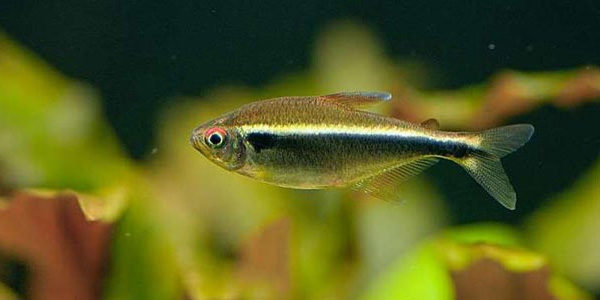
Unlike the other tetras, these feature a slender and sleek appearance. The black tetras come with a staple torpedo shape with transparent fins and a rounded head for better protection.
The exterior color of the fish is relatively lighter than what you’d imagine. It features a light greenish tint to the body with distinctive stripes on the bottom side of the body.
The first stripe on the underside has a reflective, iridescent give to it. This gives the fish the distinctive glimmering appearance and hence the “neon” in the name. Besides, that is the staple dark-colored black band.
Lifespan of Black Neon Tetra
The typical lifespan of a black neon tetra is between 4-5 years in captivity. However, the same depends on the kind of living conditions they are in.
Although the black tetras are pretty hardy fishes and can live longer than other neon tetras, all of it comes down to the care. If they don’t get the ideal water and temperature settings, the chances are that they wouldn’t live long.
If you want them to reach their full living potential, they must get the ideal living conditions, diet, and overall care.
Black Neon Tetra Size
The black neon tetra typically grows up to 1.5 inches in length. This goes to show that the fish isn’t a very large or dominating one. You can also find a few rare specimens that reach up to 1.6 inches in length, which is extremely uncommon.
The majority of them are under 1.5 inches, which regards them under the smaller size category. So, you have to be extremely cautious while choosing their tank mates if you don’t want to put them under excess stress.
Natural Habitat and Origin
It is not even a question that, like most other tetras, even the black neon tetras are tropical fishes. They are originally found in the Paraguay Basin of Southern Brazil.
As for their habitat, you will naturally find them streaming in tributaries, areas with flooded forests, creeks, and even sandbanks. This indicates that these fishes are predominantly found in areas with slow streams.
The natural condition of the water in their original habitat is highly acidic, which means that you have to mimic similar water parameters in captivity. Also, since they are found in surplus along with the decaying forests with fallen leaves and branches, the water they are in often has a brown muddy appearance.
These are scientifically named Hyphessobrycon herbertaxelrodi and are often called the “darker version” of neon tetras.
Black Neon Tetra Care and Tank Set-up
As long as you educate yourself about the care of black neon tetra, you won’t have to face any kinds of complications. The fish is easy to maintain and is an ideal choice for beginner aquarists.
All you need to do is get the fish from an ethical breeder that follows the correct protocol and is clean about the process. Besides that, follow the instructions narrated to you, and you are all set.
Following are all the information that you need to know about the tank set up for the black neon tetra:
Black Neon Tetra Tank Size and Specifications
Optimum Tank Size for Black Neon Tetra
If you want your Black Neon Tetra to thrive, you should consider a minimum 20-gallon biotope tank with dark gravel and subtly lighted since the shadowy ambiance will make your tetra show the best of its iridescent coloration.
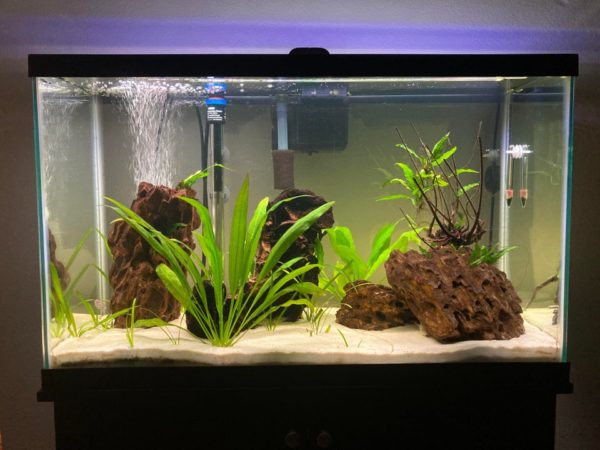
Given the size of these types of tetra, which go up to a maximum of 1.6 inches, you don’t need a larger home aquarium to house them. However, they are schooling fish.
So, you can’t even consider putting just one in the tank and expect them to survive. Instead, you need to keep at least 5-6 black tetras together to help them feel at ease. So, anything less than a 20-gallon tank isn’t recommended.
However, if you are considering building a community tank with different tank mates, we’d recommend getting a larger tank with suitable water parameters for a comfortable living condition for these tropical fishes.
Filter Type
Given the small size of the black neon tetras, they don’t generally produce much waste. However, since they are schooling fishes, you can expect the cumulative waste accumulation to be high.
And, if you skip out on a good-quality filter, the accumulated waste can end up increasing the levels of nitrate and ammonia in the tank, which can prove fatal for the fish.
So, installing a powerful filter will help clear out the tank now and then and keep it clean for the fish to move around in comfort. The filter also maintains a healthy water current in the top and middle layer of the tank, so they feel at home, much like how it is in their natural habitat.
Substrate
As for substrate, they require dark-colored substrate on the bottom of the tank for a comfortable environment. Dark sand substrate works the best and keeps them safe from bumps and accidents.
Developing a sandy bottom is what you find in their natural habitat, so including that can effectively make it a lot more comfortable for the fishes to grow in captivity.
Water Parameters for Black Neon Tetra
If you imagine the black neon tetras living in clear freshwater streams, you are completely mistaken. Unlike the few other tetra species, they are naturally found in tannin-stained water that gets its characteristic color from the fallen leaves and logs.
Most of the black neon tetras are sourced from the shallow streams in Paraguay containing decaying plant matter. While staining the water brown isn’t a key necessity in your home aquarium, you can follow the rest of the water parameters.
Water temperature
The ideal temperature of the water for black neon tetra ranges between 68°F to 82°F. The average and ideal temperature would be 75 degrees.
pH level
The perfect water pH level for black neon tetra is 5.0 to 7.5. However, we’d recommend keeping it more towards the acidic end because they get in the natural habitat.
Maintaining the pH optimally is very crucial, especially during the first days after the transfer. Sometimes, drastic changes to the pH level in the initial days can put the black tetras under stress, making it harder for them to survive.
Water hardness
The ideal water hardness level for black neon tetra is 6 dGH. Anything in excess will put the fish under stress, something that you don’t want at all.
Black Neon Tetra Tank Landscape
As with most tetras, this one is no exception when it comes to planting the tank. The Tetra’s aquarium should be heavily planted with some driftwood, branches, and twisted roots.
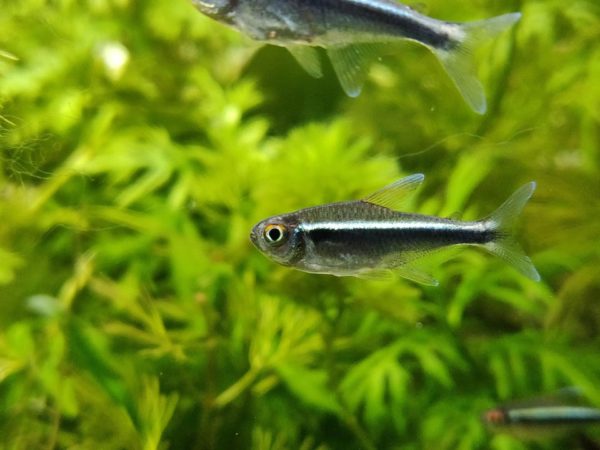
On top of that, decaying leaves and other organic materials are beneficial for this type of fish.
Recreating the natural habitat for your black neon tetra is crucial. This ensures that the black neon tetra feels at home and stays peaceful in the new surroundings. The key is to create a rich aquarium filled with leaves, live plants, and wood pieces to mimic the original surroundings.
Even though the black tetras rarely go down to the bottom of the tank, it is safer if you fill the bottom with some dark-colored sand. The best way to replicate the natural environment is to fill the bottom with some decaying leaves over the sand substrate.
The black tetras prefer staying in dimly lit or dark spaces. So, additional bright light isn’t required. This means that natural light or a low-intensity light is considered optimal.
Besides that, creating thick vegetation in the tank is mandatory. Introduce a variety of live plants in the tank, making sure that you leave enough space for the school of black tetras to swim around.
Feeding your Black Neon Tetra
This fish usually consumes smaller crustaceans, small invertebrates, filamentous algae, and fallen fruit when it comes back to its natural habitat. In the aquarium, though, they can be fed on various sorts of living, fresh, frozen, or flake food.
Although it can survive feeding on dry flake food, it will do best if offered live and frozen bloodworms, daphnia, mosquito larvae, brine shrimps, or moina. The careful addition of some vitamins and other supplements can also positively affect your tetra’s growth.
Black neon tetras aren’t very picky about their food and will most likely eat anything you give them. However, to ensure optimal health, you must feed them a variety of food options.
Also, you need to ensure that you don’t overfeed these fishes, mainly because that enhances the risks of diseases. Besides that, overfeeding can alter the water conditions and quality too.
Black Neon Tetra Behavior and Temperament
If you don’t want to put up with fin nipping and aggression and want to have a peaceful and timid fish in the home aquarium, black neon tetras are possibly the best choice.
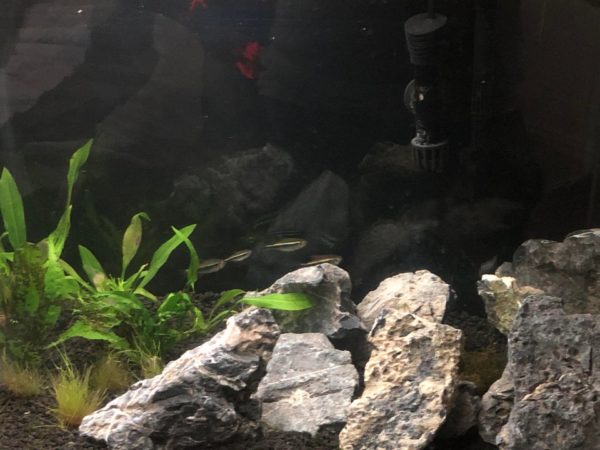
Even though they swim in schools, the male counterparts aren’t aggressive or dominant and blend in with the other fishes. This enables you to keep them in larger groups without having to worry about causing them any harm.
Since they are schooling fishes, they move around in swarms around the tank, creating a bright-colored movement that’s mesmerizing to look at. However, they are also quite independent fishes, which makes them easier to manage. Sometimes, they break apart from the schools and hideaway in the tank to get some rest.
Are black neon tetra lone or societal?
Black neon tetras are societal and like to stay in larger schools, preferably including 5-6 in one school.
Black Neon Tetra Tank Mates
Black Neon Tetra is a schooling fish that needs to be kept in the company of no less than six of its own.
Black Neon Tetras swim at the top levels of the aquarium, so it is recommended to keep some peaceful bottom-dwelling fish, such as pigmy catfish, to pick up the food falling to the bottom, so it is not left to waste.
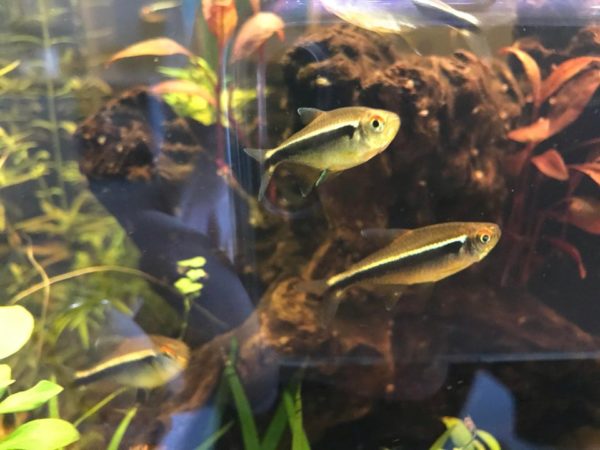
Since the mature black neon tetra grows up to just 1.5 inches, you need to be extremely careful of the kind of fish that you pair it with. They won’t welcome every tank mate that you expose them to, especially if they are larger fishes.
The last thing you want is to put them in a community tank with larger fish that will eat them up for lunch. Also, you need to avoid putting aggressive fishes like Fighters. These kinds of tank mates will put stress on them.
The best way to house them is with their kind. Not even every tetra species work well with the black neon tetras. So, some of the ideal tank mates that you can consider are:
- Harlequin Rasbora
- Neon Tetra
- Chili Rasbora
- Rummy Nose tetra
- Dwarf Gourami
- Sparkling gourami
- Pearl gourami
- Aquarium snails
- Small catfish
Make sure that you always cross-check about the water parameters for the other tank mates you consider putting inside.
Breeding Black Neon Tetra
Black Neon Tetras are bred quite easily if provided with proper water conditions, which include (approximately 80° Fahrenheit temperature, acidic conditions, and hardness under 30 ppm).
In such conditions, including a mature aquarium, a smaller number of young can appear without any intervention at all. Still, to gain some serious yield, you need to take some action.
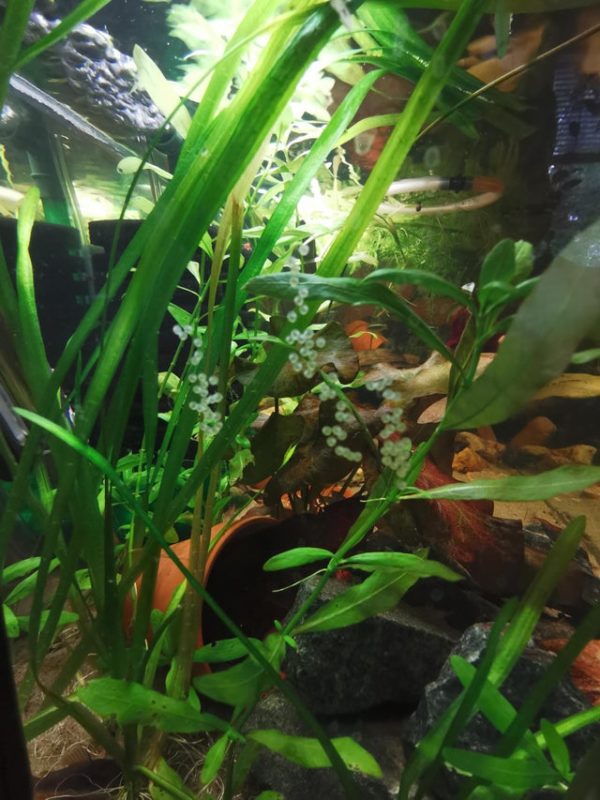
As in all tetras, this is free spawning fish, which means they release their eggs and milt into the open water. The best way to prepare for spawning is to separate males and females and feed them on many live foods.
Also, separate males and females intended for breeding from each other and from the rest of the school to perfectly control the amount and sort of food they get and other conditions needed to trigger the spawning. The indicator showing they are ready is the stage when females fatten, and the color of the males become livelier.
At that point, introduce the female and male into a 5-gallon spawning aquarium prepared previously.
Water conditions when breeding
Water in the aquarium should be mature with temperature maintained at 80° Fahrenheit, achieved by covering the tank with a towel or something similar.
The lighting should be quite dimmed. The tank should contain some kind of spawning site such as a fine-leaved plant or some artificial analog made of synthetic fabrics, like a mop made of yarn (it is easier to clean and isn’t subject to decomposing or breaking in the spawning tank).
The spawning site serves as a place for fry to attach. It would be wise to cover the bottom of the aquarium with something allowing eggs to fall through, but at the same time preventing adults from eating them (which occurs after spawning to satisfy the need for energy replenishing).
An ideal base would be a mesh, grass-like mat, a layer of glass marble, raised plastic grate, or something similar.
Observe their behavior
Ideally, females should be transferred to the spawning tank the night before males get accustomed to the new environment and get the “feeling” of being on their ground when they are introduced.
It is important to observe their behavior because if males behave overaggressively, they need to be removed back to a separately divided aquarium. The same goes for the females rejecting and attacking the males.
Once all pairs have laid eggs, transfer them back to the separate aquarium. In about 36 hours, the eggs will hatch.
Black Neon Tetra Diseases and Treatment
Like other tropical fish or tetra species, even black neon tetras aren’t immune to every aquatic disease. They are hardy and can sustain rough conditions and changing water parameters; however, drastic changes can make it difficult to survive and put them under a lot of stress.
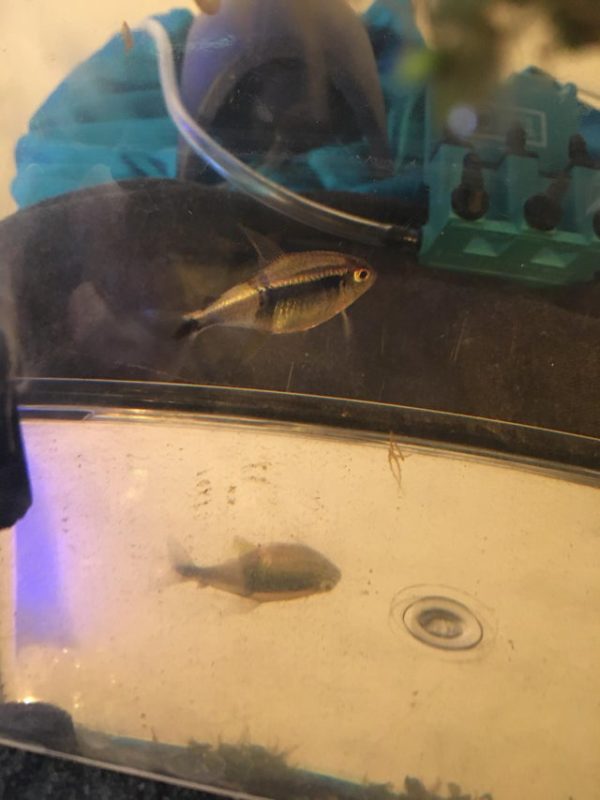
Some of the common ailments they struggle with are Ich, Dropsy, etc.
If you notice anything amiss with their movement or behavior, it is better to separate them immediately from the tank till they are better. Whatever kind of disease, black neon tetras do respond to treatment quite readily, which is a bonus.
However, we’d recommend that you prevent such conditions from happening in the first place. Clean the tank water (at least 50%) of it every few days.
Another important note to keep in mind is that black neon tetras suffer from a unique disease called “Neon Tetra Disease.” It is a type of parasitic infection that you want to keep the other tank mates away from. If you notice signs of this disease (like inflamed abdomen, restlessness, stress-induced behavior), you need to remove them from the tank immediately.
Other fishes in the school can quickly contract the infection and spread it throughout the tank if you don’t act fast enough.
Are Black Neon Tetras Right for You?
Taking care of a black neon tetra and its school is quite easy. Ideally, if you want to start with something easier, this is the best choice. However, we’d recommend educating yourself about these fishes, their requirements and the kind of space they need.
Although black neon tetras aren’t everyone’s first choice, these underrated little creatures are very fun to look at. Besides their vibrant appearance, the way they move in schools is very therapeutic to watch. And, who knows, maybe you will end up bonding with one.
FAQs
Are Black Neon Tetras Aggressive?
No, quite the contrary. Black neon tetras are peaceful fishes that roam around in their school and like to have fun in the water. Even the male ones aren’t dominant, which is another benefit. This means that you can effectively pair them with a variety of tank mates.
Are Black Neon Tetras Hardy?
Yes, they are beginner-friendly fishes and won’t die with the smallest mistakes that you commit. They have high adaptability, which is another reason why several aquarists prefer housing them.
Do Black Neon Tetras nip Fins?
No, they are not aggressive at all. Even if something is causing these fishes stress, the affected fish will detach themselves from the school and hide out in the live plants or behind the branches in the tank.
Do Black Neon Tetras Jump?
Typically, the black neon tetras prefer staying in the top or middle layer of the tank. And, since they are quite active fishes, the chances are that you will notice them come up to the surface. However, they don’t necessarily try to jump out unless the water conditions become too hostile for them.
Will Angelfish eat Black Neon Tetras?
Yes, angelfishes are comparatively larger as compared to black neon tetras. So, there are chances for them to get aggressive and eat the smaller tetras in the process. They don’t make compatible tank mates at all.
Conclusion
With all this information, we hope you consider housing a Black Tetra school in your tank. Not only are they interactive and quirky, but they are also very easy to manage, even if you don’t spend a lot of time at all.
Striking in their appearance, they are highly compatible with other kinds of peaceful and small fishes like them. Keeping them serves as a fun hobby for the aquarists, so we’d highly recommend you try housing one in your home.
